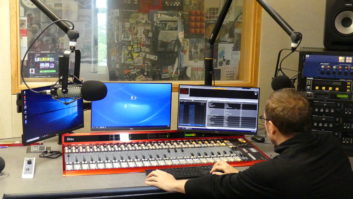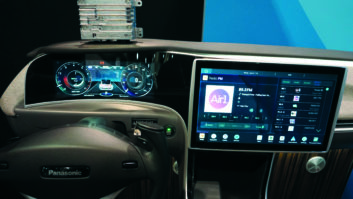A New Scrolling Display Livens Up RDS Radios
My four-year-old RDS car radio has suddenly come to life.
I’d gotten used to its relatively inert display, which occasionally provided call letters or other service-name labels for a few stations; but it was otherwise just an ordinary radio. Recently, however, when tuned to several stations, the radio’s normally static display has leapt into action and scrolled a now-playing title and artist display, along with the station ID.
Without me doing or buying anything, my radio has suddenly emerged from its permanent vegetative state and added stunning new functionality. Prior to this time, the most interesting features of my car’s audio system were its CD changer and surround-sound playback. Now the radio has eclipsed these in at least one respect, offering the first dynamic metadata ever seen inside my car.
The CD player’s display seems suddenly dull and boring, providing only cut numbers and nothing more. Radio listening is more fun, and I’m finding myself choosing the radio more often over the CD player. I’m also exploring the dial like I haven’t for a long time, trying to find the stations that offer the new service, and staying longer with the ones that do.
Compared to what
Before XM and Sirius, the only radio-style service providing this data was cable radio, which is now provided as a value-added feature in digital cable and satellite TV systems. In the latter incarnations, the metadata is displayed on the television’s screen, as opposed to the original cable radio systems, which provided a dedicated display on a set-top box or remote. But it seems a little strange to have to turn the TV on only to see artist and title information in the lower left corner of the screen, especially on a big-screen display. (To put a twist on an old saying, cable radio is like television without pictures.)
Cable radio’s metadata is also slow to load, often taking 10 or 15 seconds to fully display after a song begins. In contrast, this new scrolling RDS display exhibits minimal latency, changing almost in exact synchrony with a new song’s starting, and starting up nearly immediately upon tuning in a station that offers the service.
Today, of course, satellite radio services provide this feature on their receivers’ displays, but even these devices can exhibit a few seconds of latency.
Credit where it’s due
I must give credit for the initial discovery of this service to my 15-year-old son, who demands complete control of all media when in my car. (I shouldn’t complain; pretty soon he’ll want the entire car.)
He first pointed out that one of his favorite stations – not one I usually listen to – had begun to scroll song title and artist data, but it only appeared on the radio in my car. I explained that this was the only radio he was exposed to having RDS capability, but also that this was a brand-new feature being added to some stations’ RDS encoding.
My excitement at the latter point was lost on my son, given his generation’s deep experience with music via the Internet, MP3 players and MiniDisc, all of which have always included such data. This is now expected as a standard and essential feature of any music format by these younger consumers.
His rapid-fire channel surfing habits also quickly indicated to me how fast the new RDS display was changing, keeping up with his every move on the stations offering the service. (I have often mused whether he and his similarly fast-fingered friends will ever hear much of HD Radio’s digital audio quality in the future, given that they rarely stay on a single station for more a few seconds after tuning in.)
In any case, as I’ve driven around the country in the meantime, I’ve begun to see the service appearing on more stations every week.
Much of the real credit for the service goes to the RDS Accelerator from a Bellevue, Wash.-based company called The Radio Experience, which is enabling many of these stations to provide the new feature. This clever system enables a scrolling text display to be displayed in the PS (Program Service) field of an RDS/RBDS radio, a feature that nearly all such receivers include, and which most display in their default condition, without any user intervention or receiver settings required. Previously such text display was only possible via the RDS RT (RadioText) feature, which is not supported on all RDS radios, and which often must be manually selected for display by the user on receivers that support it.
The RDS Accelerator also optimizes RBDS Group Scheduling in the encoder to enable the fast display characteristics I experienced.
The system involves both hardware and service from The Radio Experience. The hardware includes a 1RU studio unit (or a PC-based equivalent) that interfaces with most radio automation systems via serial, TCP or text files, and multiplexes up to six stations’ programming data into a single serial or TCP stream. This signal is fed to the auxiliary data input of one or more STLs (or otherwise sent to the transmission site) and demuxed by a second 1RU device at the transmitter into individual RS-232 streams, each fed to the appropriate station’s RBDS encoder. Ethernet feeds to IBOC encoders are also enabled.
Meanwhile, the studio unit also sends its signal to The Radio Experience’s data center via the Internet, where a station’s content is identified and additional data (text, graphics and links) is added from the service’s database for simultaneous display on the station’s “now playing” Web page. This data can include CD artwork and e-commerce features for music purchase or other services.
The service can also use the Internet return path to the studio unit to adjust the data sent to the RBDS encoders, as well. This can include simply correcting typos or formatting, or it can involve the insertion of additional information from the service’s database (such as album titles), at the station’s option.
A station’s scrolling RDS message can be customized to routinely include other intermediate text – e.g., “by” between title and artist, or “on” between artist and call sign, etc.; and an “idle” message – e.g., station ID and slogan – can be set to display or scroll during commercial breaks. The latter can vary with dayparts, so a show title or other schedule-based data could be shown.
The system can also be programmed to scroll a special message whenever specified content is played, for example “appearing tonight at XYZ Club.” The interface to the service’s central database can also be used to map other custom messages to stations’ RDS streams, and coordinate them across multiple stations and groups.
The scrolling parameters can be adjusted for duration and character-advance of each sequential iteration of the PS display. (This is not a “true” scroll from receiver memory, but simply a series of PS display refreshes. Not all RDS receivers can handle rapid refreshes of the PS field, since it was expected to remain fairly static, so some practical limits on these parameters exist, and are still being discovered as the service is deployed.) The Radio Experience’s service also treats scrolling PS and RT fields independently (along with other RBDS feature management), and optimizes display of any scrolling data to the requirements of each field.
It’s important to note that a similar scrolling PS display feature has recently been enabled internally at least one other RBDS encoder that is not involved with The Radio Experience’s system, and which is now being deployed by at least one large station group.
While it produces a similar result on RDS radios, the data fed to this encoder must be interfaced and managed unilaterally by each station, and it does not include the optimization and multiplicity of integrated services offered by The Radio Experience’s back-office approach. On the other hand, such independent station usage could apply scrolling PS to other, non-program associated data (NPAD) uses, such as advertising or other messaging, which some stations apparently intend to explore.
New legs for FM
As RDS radios finally begin to proliferate in U.S. automotive audio systems, this feature will provide an exciting and valuable new service to FM radio.
It may also reduce the value of one of HD Radio’s differentiators. With an FM radio that displays dynamic digital data and sounds great when playing in a modern multi-speaker car audio system, the up-sell to an HD-Radio may be even harder to achieve among mainstream consumers.
On the other hand, a scrolling PS display of title and artist data technically violates both the European RDS and U.S. RBDS specifications, which call for that field to remain essentially static and to be used only for service-ID purposes.
Driver distraction is also a hot-button issue in the United States at present, and it would be sad if car manufacturers decided to halt their nascent growth of RDS radio offerings as a result of this trend, particularly if NPAD is widely displayed via scrolling PS. (This is why most car receivers do not include the RT feature, and why The Radio Experience offers only artist and title info, but Detroit may feel such concerns are now being circumvented by unintended use of PS.) Watch for more discussion of this topic in future issues.
Scrolling PS is appearing quickly across the United States as more stations and groups enable the service, using either The Radio Experience’s integrated service or unilateral implementations. The Radio Experience is marketing its package as the Dynamic Data Initiative, or DDI. The company’s founder and president, Allen Hartle, is an RDS pioneer who co-chairs the recently revitalized NRSC RBDS Subcommittee.
The DDI’s integration of online, FM and IBOC metadata services by a third-party aggregator, customized to the station and optimized for each delivery service, seems like an idea whose time has come for radio.
If nothing else, it’s certainly provided a welcome wake-up call to my dashboard.












